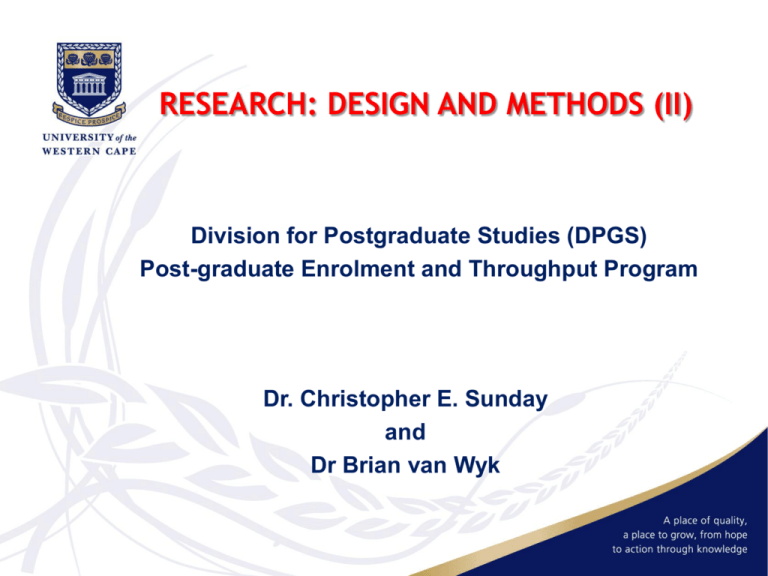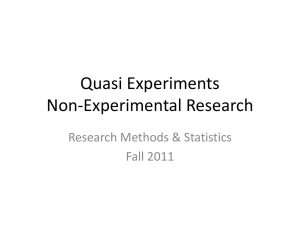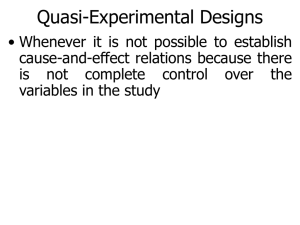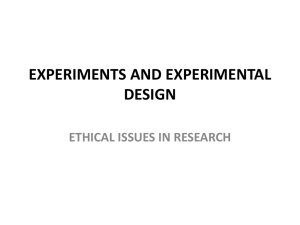RESEARCH: DESIGN AND METHODS (II)
advertisement

RESEARCH: DESIGN AND METHODS (II) Division for Postgraduate Studies (DPGS) Post-graduate Enrolment and Throughput Program Dr. Christopher E. Sunday and Dr Brian van Wyk From last meeting…. Difference between research design and research methods Different types of research designs Two main research methods: qualitative and quantitative Research design vs. Research methods Research design Research methods Focuses on the end-product: What kind of study is being planned and what kind of results are aimed at. (e.g. 1. Historical - comparative study, exploratory study, inductive or deductive study) Focuses on the research process and the kind of tools and procedures to be used. (1. Document analysis, survey methods, analysis of existing (secondary) data/statistics etc) Point of departure = Research problem or question. Point of departure = Specific tasks (data collection, sampling or analysis). Focuses on the logic of research: What evidence is required to address the question adequately? Focuses on the individual steps in the research process and the most ‘objective’ procedures to be employed. Research methods: (i) Quantitative (ii) Qualitative Quantitative research Entails the use of systematic statistical procedures to test, prove and verify hypotheses. Is best suited to the investigation of structure rather than process Can answer “how many” questions Relies on predetermined response categories and standardised data collection instruments (e.g surveys, observational check lists, structured interviews). Such instruments and procedures allow for the conversion of raw data into numbers for analysis by statistical procedures. Important concepts in quantitative research Statistical significance means that results are not likely to be due to chance factors – the probability of finding a relationship in the sample when there is none in the population. It tells the researcher whether the results are produced by random error in random sampling. Results can be statistically significant but theoretically meaningless or trivial. E.g. 2 variables can have a statistically significant association due to coincidence and no particular logical significance (e.g. length of hair and ability to speak French). One talks about Levels of statistical significance. Probability theory A branch of applied mathematics that relies on random processes. It refers to a process that generates a mathematically random result – that is, the selection process operates in a truly random method and a researcher can calculate the probability of outcomes. It is a true random process in that each element has an equal probability of being selected. Sampling in quantitative research Aims for generalisation study of a larger population. o Sample size is large o Random sampling from study population is preferred when possible, where not possible systematic or cluster sampling methods may be used And aims for verification of theory Data analysis in quantitative research I. Descriptive statistics Simple distribution (one variable) Bivariate relationships distributions) (2 variables., e.g. frequency More than 2 variables (tri/multivariate, e.g. multiple regression analysis) II. Inferential statistics Uses probability theory: to test hypotheses to draw inferences as to whether results from a random sample hold true for a designated study population. to test whether descriptive results are likely to be due to random factors or due to a real relationship. It helps researchers decide whether a relationship really exists between different sets of statistical results Steps in designing a quantitative study 1. Formulate a researchable question 2. Review related literature 3. State hypotheses 4. Determine the variables to be studied 5. Identify dependent, independent, control and other variables 6. Determine how these variables will be operational 7. Determine level of measurement 8. Determine research plan/method of data collection 9. Define population 10. Determine what instruments will be used to collect data 11. Pre-test instruments or pilot the study 12. Determine statistical tests to use Data collection in quantitative studies Experimental o Simple post-test o Classic pre-test, post-test o Pre-test, post-test, control group Analysis of quantitative data Observation o Use check or tally sheet Surveys Use questionnaires PRE- AND POST- TESTING What is it? A measurement of the learning received during the research as a result of comparing what the researcher knew before in a pretest and after the research experience in a post-test. Reasons for using a pre-test: To measure a starting point or the amount of pre-existing knowledge on the research topic To compare with the starting point of a post-test To inform the researcher about topics that are or are not needed to cover in the research based on student’s previous knowledge To indicate to the student the learning level of the research topic Reasons for using a post-test: To measure the learning as a result of the research experience To analyze the appropriateness of the research objectives To target any instructional needs to improve the research How to write a pre- and post-test? Each pre- and post-test question item should be written for each research objective. You should match the question item as close as possible to the research objectives. The question items for pre-and post-tests can be multiple choice, true/false and short answer. Begin by writing at least 10 test items based on the research objectives. Validity in quantitative research Validity in quantitative research “refers to the extent to which an empirical measurements adequately reflects the real meaning of the concept under consideration” Measures of validity Internal validity External validity Face validity Criterion-related or predictive validity Construct validity Content validity Measures of validity Internal validity: The validity with which we can infer that a relationship between two variables is real and not by chance. It relates to the possible errors or alternative explanations of results that arise despite careful controls. High internal validity = few such errors. External validity: The validity with which we can infer that the relationship between the variables investigated holds over different people, settings, times, treatment variables, and measurement variables. The ability to generalise findings from a specific setting and sample to a broad range of settings and many population groups. High external validity means that the results can be widely generalised, whereas low external validity means that they may apply only to a very specific context. TYPES OF EXPERIMENTAL DESIGN One-Shot Case Study No control group. This design has virtually no internal or external validity. Treatment Post-test X O Two Group, Post-test Comparison The main advantage of this design is randomization. The post-test comparison with randomized subjects controls the main effects of history, maturation, and pre-testing; because if no pre-test is used there can be no interaction effect of pre-test and X. Another advantage of this design is that it can be extended to include more than two groups if necessary. Treatment Post-test X O O One group Pre-test, Post-test Minimal Control. There is somewhat more structure, and a single selected group under observation, with a careful measurement being done before applying the experimental treatment and then measuring after. This design has minimal internal validity, controlling only for selection of subject and experimental mortality. It has no external validity. Pre-test Treatment Post-test O X O Two groups, Non-random Selection, Pre-test, Post-test The main weakness of this research design is that the internal validity is questioned from the interaction between such variables as selection and maturation or selection and testing. In the absence of randomization, the possibility always exists that some critical difference that are not reflected in the pretest, is operating to contaminate the post test data. For example, if the experimental group consists of volunteers, they may be more highly motivated. Group Pre-test Treatment Post-test Experimental group = E O X O Control Group = C O O Two groups, Random Selection, Pre-test, Post-test The advantage here is the randomization, so that any differences that appear in the post test should be the result of the experimental variable rather than possible difference between the two groups to start with. This is the classical type of experimental design and has good internal validity. The external validity or generalizability of the study is limited by the possible effect of pre-testing. The Solomon Four-Group Design accounts for this. Group Pre-test Treatment Post-test Experimental group = E (R) O X O Control Group = C (R) O O Solomon Four-Group Design This design overcomes the external validity weakness in the above design caused when pre-testing affect the subjects in such a way that they become sensitized to the experimental variable and they respond differently than the unpre-tested subjects. Group Pre-test Treatment Post-test Pre-tested Experimental Group = E (R) O X O Pre-tested Control Group = C (R) O Unpre-tested Experimental Group = UE (R) Unpre-tested Control Group = UC (R) O X O O QUALITATIVE RESEARCH This is sometimes referred to as ‘descriptive study’, ‘field study’, ‘participant observation’, ‘case study’ or ‘naturalistic research’. The aim of qualitative type research is to “get close to the data in their natural setting” (versus counting and statistical techniques at a distance from the data): it is designed to best reflect an individual’s experience in the context of their everyday life. It uses smaller sample sizes than quantitative studies and digs deeply for data. QUALITATIVE RESEARCH …cont. Emphasises comprehensive, interdependent, and dynamic structures. Is appropriate in the investigation of complex, interdependent issues, and allows for the collection of rich data that can answer the “what” and “why” qualitative questions, and not just the “how many” quantitative research questions Often draws on multiple sources of data Given its strength in generating/developing theory (inductive), qualitative research is particularly appropriate for the investigation of research problems that are under-theorised. Data collection in qualitative research Participant observation Case studies Formal and informal interviewing Videotaping Archival data surveys OR document review Data analysis in qualitative studies Discourse analysis Narrative analysis Content analysis Thematic analysis Sampling in qualitative research Sampling is mostly purposive – with specific criteria in mind! Seek conceptual applicability rather than representativeness (quantitative representativity) You want to capture the range of views/experiences Or seek after/pursue saturation of data Or to draw theory from data. Triangulation in qualitative research Data triangulation – multiple data sources to understand a phenomenon Methods triangulation – multiple research methods to study a phenomenon Researcher triangulation – multiple analysing and interpreting the data investigators in Theory triangulation – multiple theories and perspectives to help interpret and explain the data






